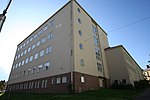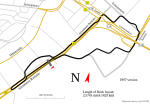Vaasanpuistikko

Vaasanpuistikko (Swedish: Vasaskvären, unofficial name Vaasanaukio), meaning "Vaasa park", is an area in Helsinki, Finland, surrounded by the streets of Helsinginkatu, Vaasanpolku and Pengerpolku around the western entrance to the Sörnäinen metro station, near the so-called Sörnäinen curve. Even though Vaasanpuistikko is located in the neighbourhood of Alppiharju, it is commonly thought of as a part of Kallio. Vaasanpuistikko is connected with Vaasankatu. Around Vaasanpuistikko are located the Sörnäinen metro station, a pawn shop, a self-defense school, a gym, a driving school and an S-market shop. There are numerous bars, pizzerias and other restaurants located nearby. Helsinki city council member Kimmo Helistö made a proposal in 2007 to rename the square as "Arto Mellerin aukio" after the poet Arto Melleri, but the proposal was not supported.Vaasanpuistikko is sometimes humorously referred to with the nicknames "Piritori" ("Amphetamine square") and "Ikuisen vapun aukio" ("Square of the eternal Walpurgis Night").
Excerpt from the Wikipedia article Vaasanpuistikko (License: CC BY-SA 3.0, Authors, Images).Vaasanpuistikko
Vaasanpuistikko, Helsinki Alppiharju (Central major district)
Geographical coordinates (GPS) Address Website Nearby Places Show on map
Geographical coordinates (GPS)
| Latitude | Longitude |
|---|---|
| N 60.187777777778 ° | E 24.960555555556 ° |
Address
Sörnäinen (M) (kaupunkipyörä)
Vaasanpuistikko
00500 Helsinki, Alppiharju (Central major district)
Finland
Open on Google Maps











